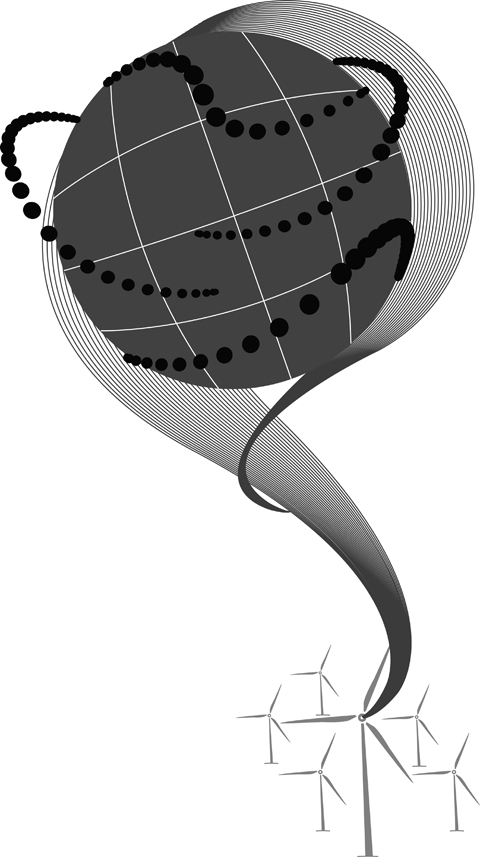Humanity’s future, to say nothing of its prosperity, will depend on how the world tackles two central energy challenges: securing reliable supplies of affordable energy and switching to efficient low-carbon energy.
The Reference Scenario — in which no new policies are introduced — in the International Energy Agency’s (IEA) World Energy Outlook 2008 sees annual global primary energy demand growing 1.6 percent on average up to 2030, from 11,730 million tonnes of oil equivalent (Mtoe) to just over 17,010 Mtoe — an increase of 45 percent in just over 20 years.
China and India account for just over half of this increase, with Middle Eastern countries contributing a further 11 percent to demand. Non-OECD countries account for 87 percent of the increase, so their share of world primary energy demand will rise from 51 percent to 62 percent.

Most oil production increases are expected to come from just a few countries — mainly in the Middle East, but also Canada with its vast oil-sands reserves, the Caspian region and Brazil. Gas production in the Middle East will triple, and more than double in Africa, where there are large low-cost reserves.
The trend by which consuming countries grow steadily more reliant on energy from a small number of producing countries threatens to exacerbate energy-security worries. This year’s supply stand-off between Russia and Ukraine made these worries crystal clear in Europe, where gas imports are set to rise to 86 percent of demand by 2030 from 57 percent in 2006.
Of course, increasing import dependence does not necessarily mean less energy security, any more than self-sufficiency guarantees uninterrupted supply. Yet greater short-term insecurity seems inevitable as geographical diversity of supply is reduced and reliance on vulnerable supply routes grows.
Longer-term energy-security risks are also set to grow. As a small group of countries increasingly accounts for the world’s remaining oil reserves, their market dominance may threaten the pace of investment. The greater the demand for oil and gas from these regions, the more likely these regions are to seek higher prices and to maintain them by deferring investment and limiting production.
Unfettered growth in energy demand will clearly have serious consequences for the climate as well. Under the Reference Scenario, which represents “business as usual,” the IEA points to continuing growth in carbon dioxide and other greenhouse-gas emissions; carbon dioxide emissions are projected to rise 45 percent by 2030, with other greenhouse gases contributing to an eventual average temperature increase of up to 6ºC.
Three-quarters of the extra carbon dioxide will come from China, India and the Middle East, and as much as 97 percent from non-OECD countries as a whole — though non-OECD per capita emissions will still be far lower on average than in the OECD. Bucking the global trend, only the EU and Japan will see lower emissions in 2030 than today.
The energy sector has a relatively slow rate of capital replacement because of the long lifetimes of much of its infrastructure. More efficient technologies normally take many years to spread through the energy sector. As a result, both public and private sectors must accept the need for additional investments, as well as the potential costs of early capital retirement, in order to accelerate this process and deliver deep cuts in emissions.
Two IEA climate-policy scenarios show how we could stabilize the concentration of greenhouse gases at 550 or 450 parts per million of carbon dioxide equivalent. The 550 scenario equates to an increase in global temperature of approximately 3ºC, while the 450 scenario implies an increase of around 2ºC.
In the 550 scenario, energy demand up to 2030 rises by about 32 percent, with the share of fossil fuels falling markedly, and average demand up 1.2 percent yearly, compared with 1.6 percent in the Reference Scenario. Energy-related carbon dioxide emissions would peak in 2025 and decline slightly by 2030.
The 450 scenario presents an immense challenge. The 2030 emissions level for the entire world would be less than the emissions projected for non-OECD countries alone in the Reference Scenario. In other words, even if OECD countries reduce their emissions to zero, they alone could not put the world onto the 450ppm trajectory. To do so would mean a technology shift that — in terms of scale and speed of deployment — is unprecedented.
The good news is that we already know many of the policies and technologies that can deliver substantial savings in energy consumption and carbon dioxide emissions. But making and implementing the right decisions must begin now.
We’re talking about significant changes in the pattern of investment across the supply and demand chains, as well as huge additional spending on new capital stock, especially in power plants and in more energy-efficient equipment and appliances.
Although the sheer scale of the transformation means placing a substantial burden on both public and private sectors, the current financial crisis should be used as an opportunity rather than as a barrier to launching it.
Renewable energy will have a major role to play. Global renewables-based electricity generation (mainly hydro and wind, but also solar and biomass) is set to double between 2006 and 2030. In the EU, wind’s share in total power generation is set to rise to 14 percent by 2030 from 2 percent today, and would account for well over half the total increase in the EU’s power generation. In the 450 scenario, renewables will be 30 percent of the EU’s power generation mix in 2030, up sharply from 10 percent today.
Governments must galvanize this transformation. Clear price signals, including carbon pricing, are crucial, and many non-OECD countries, in addition to needing financial support to help reduce their greenhouse gas emissions, can benefit from the removal of fuel subsidies.
But clear price signals are not enough, as a low-carbon future requires major breakthroughs in technology development and deployment. Governments can create incentives to innovate, encourage research and break down international barriers. And much of the additional spending needs to be made by households, driven by a profound change in social attitudes to energy efficiency.
Fatih Birol is chief economist at the Paris-based International Energy Agency.
COPYRIGHT: PROJECT SYNDICATE

As strategic tensions escalate across the vast Indo-Pacific region, Taiwan has emerged as more than a potential flashpoint. It is the fulcrum upon which the credibility of the evolving American-led strategy of integrated deterrence now rests. How the US and regional powers like Japan respond to Taiwan’s defense, and how credible the deterrent against Chinese aggression proves to be, will profoundly shape the Indo-Pacific security architecture for years to come. A successful defense of Taiwan through strengthened deterrence in the Indo-Pacific would enhance the credibility of the US-led alliance system and underpin America’s global preeminence, while a failure of integrated deterrence would
It is being said every second day: The ongoing recall campaign in Taiwan — where citizens are trying to collect enough signatures to trigger re-elections for a number of Chinese Nationalist Party (KMT) legislators — is orchestrated by the Democratic Progressive Party (DPP), or even President William Lai (賴清德) himself. The KMT makes the claim, and foreign media and analysts repeat it. However, they never show any proof — because there is not any. It is alarming how easily academics, journalists and experts toss around claims that amount to accusing a democratic government of conspiracy — without a shred of evidence. These
Taiwan is confronting escalating threats from its behemoth neighbor. Last month, the Chinese People’s Liberation Army conducted live-fire drills in the East China Sea, practicing blockades and precision strikes on simulated targets, while its escalating cyberattacks targeting government, financial and telecommunication systems threaten to disrupt Taiwan’s digital infrastructure. The mounting geopolitical pressure underscores Taiwan’s need to strengthen its defense capabilities to deter possible aggression and improve civilian preparedness. The consequences of inadequate preparation have been made all too clear by the tragic situation in Ukraine. Taiwan can build on its successful COVID-19 response, marked by effective planning and execution, to enhance
Since taking office, US President Donald Trump has upheld the core goals of “making America safer, stronger, and more prosperous,” fully implementing an “America first” policy. Countries have responded cautiously to the fresh style and rapid pace of the new Trump administration. The US has prioritized reindustrialization, building a stronger US role in the Indo-Pacific, and countering China’s malicious influence. This has created a high degree of alignment between the interests of Taiwan and the US in security, economics, technology and other spheres. Taiwan must properly understand the Trump administration’s intentions and coordinate, connect and correspond with US strategic goals.